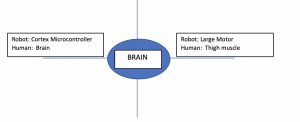2023 Week 2 – So just how powerful is our Central Nervous System?
Week 2 – How powerful is our Central Nervous System?
Over the past few decades, computers have become increasingly more powerful thanks to faster processing speeds and greater storage capacity. This, in turn, has allowed us to become more efficient at work and school. Additionally, computer software helps us be more productive, solve complicated math problems, and communicate with people all around the world.
- Do you think that a computer is more powerful than a human brain?
- Can a computer do everything that a human brain does?
- Make a list of specific ways in which a computer and the human brain might be alike.
The Central Nervous System consists of both the brain and spinal cord.
First, let’s think about the command center of your body, the brain. When looking at the human brain and a computer, we see that there are similarities. They both process and store information in order to perform tasks. They both utilize electrical signals in order to communicate. While a brain uses neurons to send communication signals, a computer uses the binary system of 1’s and 0’s.
Now, let’s think about the spinal cord. Our spinal cord is used much like the wires on our robot. Just as the nervous system sends messages from the brain all over the human body, the wires on our robot connect and send information to the motors and sensors located on the robot.
Resources
- Best Robotics
- The Nervous System | Video for Kids
- Operation Ouch – The Spinal Cord | Biology for Kids
- Operation Ouch – The Brain | Amazing Body Facts for Kids
- Maybe the best robot demo ever | Marco Tempest
- Label the parts of the brain worksheet
Materials
- Scissors, Glue, Journal.
- Optional: Colored Pencils
Research/Reflect/Brainstorm
Grab a notebook or your journal and research the following:
- Watch the video “Operation Ouch – The Brain | Amazing Body Facts for kids”. Research the parts of the human brain. Now, make a list of the different parts of the brain and their functions.
- Watch the video “Operation Ouch – The Spinal Cord | Biology for Kids”. Examine how the spinal cord functions within the central nervous system. How do the spinal cord and brain work together?
- Watch the Ted Talk Video, “Maybe the best robot demo ever.” Next, grab your journal and list 3 to 5 things you found interesting in the video.
Activity
Group (if possible) “Think – Pair – Share”. First, think about the similarities and differences between your robot’s brain and your brain. Now, think about the similarities and differences between your spinal cord and the robot’s wiring. Second, pair up with a partner to share your thoughts. Next, you and your partner share with your class what you have found; you share what your partner shared with you and they share what you said to the class.
Individual – Journal what you and your partner came up with in the “Think – Share – Pair”. Create a list of what was similar and different with both the brain, spinal cord and the robot itself. Add in what people from your class shared.
Additional Activity:
First, print out the diagram “Label the parts of the brain worksheet”. Then paste it to your journal and label each part of the brain.
PARTS OF THE BRAIN WORKSHEET – click here to access the worksheet
BEST connection
In this exercise, you will dig into the different components found in the BEST robotics kit and then compare it to the human body. You will first need to go to BEST Robotics website then open up the PDF files “2019 BEST Returnable Kit List” and “2019 Consumables Checklist”. Once you have opened up the file, grab your journal and start comparing robot parts to the human body. It will look something like the following diagram:

Community Connection
As we have learned thus far, the brain is the command center for our entire body. It’s responsible for making thousands of decisions and choices on a daily basis. Once those conclusions have been made it is sent out to the spinal cord where the messages are relayed throughout our body. The brain is able to process lots of information and adapt to changes based on how it is programmed. How are decisions in your school or in your community made when something occurs that requires an adaptation or change, like a natural disaster or pandemic? Is there a series of steps that take place, much like a computer program instructs the robot how to react when it runs into a wall? What are those steps? Do all of the parts of the community work together to overcome the obstacle? What part do you play?
Try to answer these questions and if possible discuss them with your team or friends.
Bloom’s Taxonomy: create, explore, evaluate, generate, include, identify, list, observe, reflect, review , use, and write
Workforce Skills – list workforce skills related to this lesson
Critical thinking, Collaboration, materials evaluation, reading comprehension, science, writing, research
Please feel free to add as many comparisons as you can think of.
My Personal Journal